See more of our stories: Nunavut at 20
The view in Pangnirtung, ᐸᖕᓂᖅᑑᖅ Nunavut is breathtaking.
Nestled in the Qinkiqtaaluk region, the hamlet of roughly 1,400 lies beside the southern Baffin mountains.
Houses sparsely dot the land that weather some of the harshest climates in Canada.
Inuit families have inhabited the area for thousands of years.
In 1921, the Hudson Bay Company established a trading post here, and two years later, the RCMP set up a permanent office, followed by the first government-appointed teacher in 1956.
Although Pang, as it’s known, is a place of great tradition and skill for the current generation of youth, this is also a place of hardships.
In the spring of 2018 more than ten youth attempted suicide.
Headlines swirled from southern media outlets asking how such a tragedy could happen.
But the spotlight was brief.
(Pangnirtung has a population of about 1,400. Photo courtesy: Jessica Davey-Quantick/UpHere Magazine)
APTN News travelled to Pang for a week in Jan. 2019.
For the respect and care for those we interviewed, who are affected from the loss of loved ones, we did not delve into this topic.
Instead we asked what everyday life was like for those that live here.
Denise Nowyuk is 19 years old.
She is your typical teenager; she saves her money earned by her part-time gig at gas bar for trips down south, loves fishing, and picks berries in the summer.
(“I dropped out when I was in grade 10… I am really close to finishing,” says Denise Nowyuk )
She is also a natural leader and occupies such positions as the President of the Pangnirtung Youth Council, the student representative for the DEA and the youngest board member for the CO-OP.
“Maybe ‘cause I am not shy, I like to talk in front of people. I like to talk when there is a lot of people,” she said.
Like all Inuit who choose to attend university, Nowyuk must go down south for her education.
This fall she will attend Nunavut Sivuniksavut, a transitional education program for Inuit in Ottawa.
But, her dreams of academia did not come easy.
“I dropped out when I was in grade 10. Then seeing people my age graduating I felt like I had to go back and now I am really close to finishing,” Nowyuk said.
She told APTN that it is not because youth don’t want to graduate, they just have trouble attending class.
There are many reasons why Nunavummuit aren’t attending high school, responsibilities at home, a revolving door of new teachers, the transition between an educated rooted in teaching rather than hands on learning and a southern curriculum are just to name a few.
According to Nowyuk, the biggest hurtle for youth in their development is dealing with sheer boredom.
“We don’t have a youth center; we don’t have a lot of places to go. People usually just hang out outside the school, the stores, the arena but I think it is closed now,” she said.
(“They’re looking for something to do,” says Eric Lawlor.)
The youth centre was forced to close after federal funding dried up in 2015.
Since then Eric Lawlor, the former manager of the centre has seen a rise in youth getting into trouble.
“Idle hands. They’re looking for something to do and sometimes what they find to do is not always the best thing to get into.
“People need a place to socialize, there’s nowhere to go to just relax,” Lawlor said.
Lawlor is Metis and originally from New Brunswick, but has lived in Pang for 15 years.
His home is bustling with kids.
He and his wife have three of their own and two foster kids. He calls himself “father of five but a Dad to a dozen.”
(A fishing boat in “Pang” waits for the late spring thaw. Photo: Charlotte Morritt-Jacobs/APTN)
But raising a big family in Pang has comes with many challenges.
The night before his 10-month-old foster son Dale ran a fever.
There was no doctor around and the five-man nursing station was chronically understaffed so he had no option but to be medevac’d to Iqaluit.
“We were stuck there for three days and we had to go to the boarding home. When we arrived the place was packed and there were probably 20 some people waiting for rooms, all the hotels were booked,” he said.
In the 2019 Nunavut budget, $90 million is allocated to medical travel, with nearly all of that to be spent directly on medical air travel.
The lack of a permanent doctor is just one item in the long laundry list of issues that compound health problems here.
In most Pangnirtung homes you will find cold linoleum floors, larger windows boarded up with plywood all winter long, and a bottle of antifreeze in the bathroom to be poured down the drain after each shower to ensure the pipes don’t freeze.
“The biggest issue is just the over crowdedness where you’re dealing with sometimes two, three families, 14 people living under the same roof, three bedrooms. Trying to find a place to sleep, the amount of food they go through and conflict that can create,” Lawlor said.
Lawlor now works as the Community Economic Devloper and is putting all of his energy into improving housing with a pilot project to bring 10 units powered by solar and wind.
For Nowyuk, she knows that when she returns from school she, like most youth will have to live with her parents to be able to afford rent.
She told APTN News that she wants to come back to Pang once she is done school and knows the troubles plaguing Pang require a collective approach.
“The other youth really look up to me, they always tell me that they won’t be sure what they will do when I am done high school.”
The social, economic and geographic complexities of Pangnirtung go far beyond simple adjectives like “remote” or “isolated.”
To look at the challenges of communities in Nunavut is to acknowledge those hoping to make it better like Denise Nowyuk and Eric Lawlor.
















On a world wide basis there are problems when it comes to rural areas, they are all exposed to isolation and lack of opportunities. Native cultures are more prone to this and the lose of culture due to the pressure of assimilation.into the dominate culture. When the jobs and “opportunities” lies outside of ones community there is pressure to go where the jobs are. There is a slow but steady erosion of culture. From the houses we live in, to the foods that we eat; all tells us about who we are as a people. Although, the sense of isolation is a state of mind, and that state of mind can change when one feels connected to the larger body of community. In the push for renewable energies there is a world wide movement for solar and wind generators. With the rise of renewable energy comes jobs and development. Can the aboriginal communities develop the where-with-all to create cooperative energy farms to provide the energy they need and larger communities in general. Furthermore, can they sell their surplus to the major cities in the province? Aboriginal peoples have the land, but not the resources to provide for themselves and create sustainable cooperative economy. Give a person a fish, and they will eat for a day Teach a person to fish, and they will feed themselves for generations. Renewable energy; renewable communities.